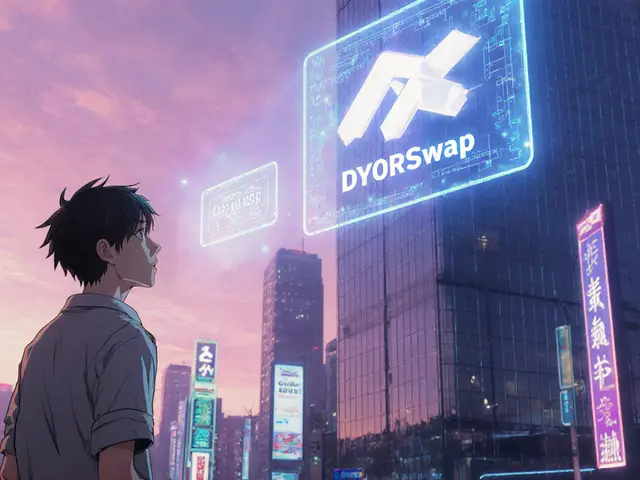DYORSwap Slippage Calculator
Trade Calculator
When you hear the name DYORSwap, the first thing that pops up is its tight link to the Sonic blockchain. DYORSwap is the native decentralized exchange (DEX) built on the Sonic network, designed to let users trade SONIC‑based pairs without relying on Ethereum‑layer‑2 solutions. It operates as an automated market maker (AMM) with a 0.3% fee model and deep integration into Sonic’s validator economics. Sonic blockchain is a Layer 1 protocol rebranded from Fantom, launched in Q2 2024, and optimized for DeFi with sub‑second finality and ultra‑low gas costs. If you’re wondering whether DYORSwap lives up to the hype, this review breaks down the numbers, the user journey, and the risks so you can decide if it’s worth a try.
Key Takeaways
- DYORSwap tops the Sonic ecosystem for SONIC‑WS trading but holds a DYORSwap review niche with only $290 daily volume.
- Liquidity is shallow - a $500 trade can shift the price more than 2%.
- Fees stay low (0.3% + tiny gas), yet you need S‑tokens to pay gas on Sonic.
- Onboarding is complex: acquire SONIC on a CEX, bridge via Sonic Gateway, then hold S for fees.
- Future upside hinges on Sonic’s liquidity‑mining program and broader adoption.
What DYORSwap Does - The Basics
At its core, DYORSwap mirrors Uniswap’s AMM design: you drop two tokens into a pool, the smart contract sets a price curve, and traders swap against that curve. The platform currently supports only SONIC‑based pairs, the most active being SONIC/WS (Wrapped Sonic). According to CoinGecko’s October 2025 snapshot, that pair alone accounts for 101.09% of the exchange’s 24‑hour volume, meaning almost every trade on DYORSwap involves SONIC.
Liquidity and Trading Metrics
Liquidity is the lifeblood of any DEX. DYORSwap shows a 0.62% spread, $514 depth at +2% and $512 depth at -2% for its flagship pair. In plain English, a $500 trade will push the price by roughly 2%, leading to noticeable slippage. Compare that with Uniswap V3’s average depth of $5 million for similar‑sized pairs and PancakeSwap’s $3.2 million - DYORSwap’s pools are tiny.
Daily trading volume sits at $290, which is less than 0.000024% of Uniswap’s $1.2 billion daily flow. The reality is that only a handful of Sonic‑native users are swapping, and most of them are moving small amounts for testing or token‑distribution purposes.
Fee Structure and Economic Model
Standard DEX fees on DYORSwap are 0.3% per swap. Sonic’s unique twist is that dApps built on the chain can retain up to 90% of the blockchain fees, a stark contrast to Ethereum where fees are burned or go to miners. This model is meant to encourage developers to stay within the Sonic ecosystem instead of launching separate Layer 2 solutions.
Gas fees on Sonic are practically negligible - around $0.0001 per transaction - but you still need S‑tokens to cover them. Validators must stake 500,000 S (about $42) to secure the network, and users without S can get stuck when attempting to claim bridged assets. That circular dependency is the most common complaint across Reddit and Discord channels.

User Experience: Onboarding Hurdles
Getting onto DYORSwap is a multi‑step marathon:
- Buy SONIC on a centralized exchange (Binance, KuCoin, MEXC).
- Withdraw to a wallet that supports Sonic (MetaMask with custom RPC, or the native Sonic wallet).
- Bridge your assets via the Sonic Gateway to move ETH or other tokens onto Sonic. The bridge promises ~10 minute transfers, but real‑world failures push wait times to hours.
- Acquire a small amount of S‑tokens to pay gas for the bridge and any subsequent swaps.
- Enter DYORSwap, select the SONIC/WS pair, and trade.
Coincub’s June 2025 usability test found that 78% of first‑time users needed help, and the average onboarding time was 47 minutes. By contrast, swapping on Uniswap usually takes under 5 minutes for a seasoned crypto user.
Security, Risks, and Community Sentiment
From a security standpoint, DYORSwap inherits Sonic’s consensus model - proof‑of‑stake with fast finality (<2 seconds). There have been no major hacks reported as of October 2025. However, the platform’s reliance on the Sonic Gateway introduces a single point of failure; if the bridge is down for more than 14 days, users can still withdraw assets back to Ethereum via a fail‑safe, but only if they have the necessary S to pay gas.
Community sentiment is lukewarm. Telegram’s “Sonic Degens” group shows an average rating of 2.8/5, with frustration centered around bridging complications and the need for S‑tokens. Positive notes focus on transaction speed once the setup is complete - a user swapped 10,000 SONIC in 1.2 seconds, which is impressive but not very meaningful given SONIC’s low price.
How DYORSwap Stacks Up Against the Big DEXs
| Metric | DYORSwap | Uniswap V3 | PancakeSwap |
|---|---|---|---|
| 24‑h Volume (USD) | $290 | $1.2 B | $800 M |
| Average Depth (+2% / -2%) | $514 / $512 | $5 M+ / $5 M‑ | $3.2 M+ / $3.2 M‑ |
| Spread | 0.62% | ~0.3% (varies) | ~0.4% |
| Gas per Tx (USD) | $0.0001 | $0.03‑$0.15 | $0.01‑$0.03 |
| Token Pairs | SONIC‑based only | Hundreds across multiple chains | Multi‑chain pool |
The table makes it clear: DYORSwap excels in speed and gas cost, but it lags dramatically in liquidity, pair variety, and overall activity. If you need a deep order book or want to trade a wide range of assets, you’ll gravitate toward Uniswap or PancakeSwap.

Future Outlook and Roadmap
Sonic announced a Q4 2025 liquidity‑mining program aimed at boosting DYORSwap’s pools. The incentive plan distributes additional SONIC tokens to LPs who stake in the SONIC/WS pool, with a target of raising depth to $5,000 on each side. Early signs are modest - the depth grew from $200 to $514 in the past month.
Price expectations for SONIC are split. CoinLore’s long‑term model predicts a $5.16 price by 2040 (a 61,000× jump), while TradingBeast’s 2025 forecast caps it around $0.30. Because DYORSwap’s health is tied to SONIC’s market cap (≈ $97 M) and adoption, any bullish move in SONIC will automatically deepen the DEX’s liquidity.
Regulatory clarity remains vague. Sonic has no published compliance framework, placing it in the same gray area as most DEXs. If regulators tighten rules around on‑chain bridges, DYORSwap could face additional compliance hurdles.
Should You Try DYORSwap?
If you’re a Sonic‑native developer or an early‑adopter who wants ultra‑fast swaps and is comfortable holding S‑tokens, DYORSwap offers a low‑cost playground. For the average DeFi trader who values liquidity, a broad token selection, and minimal onboarding friction, the platform feels more like an experimental side‑project.
Bottom line: the exchange’s technology is solid, but the market reality-tiny pools, steep onboarding, and a niche token list-means it’s not yet ready for serious trading. Keep an eye on the upcoming liquidity‑mining launch; if depth climbs into the low‑thousands, the slippage risk will drop, and the DYORSwap experience could improve dramatically.
Frequently Asked Questions
What is DYORSwap?
DYORSwap is the native decentralized exchange on the Sonic blockchain. It lets users trade SONIC‑based token pairs using an automated market maker model.
How fast are transactions on DYORSwap?
Sonic’s consensus reaches finality in under 2 seconds, so swaps on DYORSwap usually settle within a second after the transaction is submitted.
Why do I need S‑tokens to use DYORSwap?
S‑tokens are Sonic’s native gas token. Every on‑chain action-including bridging assets and swapping-requires a small amount of S to pay transaction fees.
Is DYORSwap safe?
The platform inherits Sonic’s proof‑of‑stake security model, and no major hacks have been reported. However, reliance on the Sonic Gateway bridge introduces a potential point of failure.
What are the main drawbacks of using DYORSwap?
Low liquidity causing high slippage, limited token pairs, a complex onboarding process that demands S‑tokens, and dependence on Sonic’s overall adoption.



Marina Campenni
July 12, 2025 AT 23:04I can see why the low fees and sub‑second finality are attractive, but the shallow liquidity really limits any serious trading strategy. The 0.3% fee is standard, yet the need for S‑tokens to pay gas adds an extra hurdle for newcomers. If you’re just testing the waters, the onboarding steps are tolerable, but repeated swaps will quickly feel cumbersome. Overall, DYORSwap feels like a niche playground rather than a fully fledged DEX.
Irish Mae Lariosa
July 21, 2025 AT 06:39The review correctly identifies that DYORSwap operates on the Sonic blockchain, a Layer‑1 that was rebranded from Fantom in the second quarter of 2024, and this historical context is essential for understanding its design choices. However, the assertion that a $500 trade shifts the price by more than two percent warrants a deeper examination of the underlying constant‑product formula, which inherently penalizes large orders in thin pools. In practice, such price impact translates into slippage that can erode the modest 0.3% fee, especially when users attempt to arbitrage between Sonic‑based pairs and their Ethereum equivalents. Moreover, the daily trading volume of $290, while numerically modest, represents a fraction of the total activity on established platforms such as Uniswap V3, whose daily throughput exceeds one billion dollars. This disparity is not merely a statistical footnote; it signifies a liquidity deficit that discourages institutional participation and perpetuates a feedback loop of low depth and low volume. The reliance on S‑tokens for gas, although technically efficient due to Sonic’s near‑zero transaction costs, introduces a circular dependency that can trap users lacking sufficient staking balances. From a security perspective, inheriting Sonic’s proof‑of‑stake consensus does provide rapid finality, yet it also concentrates power among validators who must stake half a million S each, a barrier that may dissuade decentralised validator participation. The bridge mechanism described, promising ten‑minute transfers, often fails to meet that benchmark, leading to user‑experience friction that rivals or exceeds that of more mature cross‑chain solutions. Additionally, the community sentiment captured in Reddit and Discord channels highlights a recurring complaint: the inability to claim bridged assets without holding S, effectively gate‑keeping the ecosystem. While the fee redistribution model-allowing dApps to retain up to ninety percent of blockchain fees-appears generous, it may inadvertently distort market incentives by privileging developers over end‑users. In the broader DeFi landscape, where gas fees on Ethereum have begun to stabilise and layer‑2 solutions proliferate, Sonic’s unique economics must demonstrate tangible value beyond novelty. The upcoming liquidity‑mining program could inject the necessary capital, but its success hinges on clear incentives and transparent reward structures. Absent such measures, the platform risks remaining a sandbox for experimental trades rather than evolving into a competitive exchange. Ultimately, potential adopters should weigh the allure of ultra‑low gas against the practical challenges of liquidity, onboarding complexity, and token‑specific dependencies, making an informed decision based on their risk tolerance and usage patterns.
Nick O'Connor
July 29, 2025 AT 14:14Indeed, the protocol’s architecture-built atop the Sonic consensus-offers rapid finality, yet, the associated user experience-marked by a multi‑step onboarding process-can be daunting, especially for those unfamiliar with custom RPC configurations; the necessity of acquiring S‑tokens for gas, while theoretically efficient, adds another layer of operational friction.
Sara Stewart
August 6, 2025 AT 21:49Absolutely, the liquidity constraints you described are a classic case of thin‑pool dynamics, and the 0.3% fee-while industry‑standard-doesn’t compensate for the slippage risk; that’s why the upcoming liquidity mining incentives could be a game‑changer, potentially boosting depth and reducing price impact across SONIC‑WS pairs.
Laura Hoch
August 15, 2025 AT 05:24From a philosophical standpoint, the trade‑off between accessibility and ecosystem integrity mirrors the broader debate in decentralized finance, where the pursuit of ultra‑low gas costs must be balanced against the necessity for robust liquidity and user‑friendly onboarding mechanisms.
Hailey M.
August 23, 2025 AT 12:59Wow, DYORSwap feels like a roller‑coaster ride-low fees, lightning‑fast finality, but a labyrinthine bridge that can make anyone lose their cool 😅
Still, the novelty factor keeps me coming back for another spin.
Schuyler Whetstone
August 31, 2025 AT 20:34Listen, if you keep whining about the bridge delays, you’re ignoring the bigger picture-this platform is built on a chain that rewards validators, and you can’t expect a free lunch when you’re not staking S tokens, it's just common sense.
Pierce O'Donnell
September 9, 2025 AT 04:09Liquidity is basically non‑existent.
Bobby Lind
September 17, 2025 AT 11:44Hey folks, despite the hurdles, I think DYORSwap's ultra‑low gas fees could eventually attract a niche community of traders who value speed over volume.
Let’s give the platform some time to grow.
Deepak Kumar
September 25, 2025 AT 19:19Exactly! To get started, first add the Sonic network to MetaMask using the RPC URL, then acquire a modest amount of S‑tokens-just enough to cover bridge fees-and finally test a small swap on the SONIC/WS pool; this step‑by‑step approach usually takes under ten minutes once you’ve got the basics down.
Miguel Terán
October 4, 2025 AT 02:54What you’re missing is the cultural context of the Sonic ecosystem its community thrives on rapid iteration and a shared belief in decentralised governance which means that even small participation can have outsized impact on network security and token utility so when you stake those S tokens you’re not just paying gas you’re also signalling trust and aligning with a broader vision of a truly permissionless finance landscape that transcends traditional barriers and opens doors for creators worldwide
Shivani Chauhan
October 12, 2025 AT 10:29In my experience the dual‑tone approach-mixing formal protocol explanations with informal guidance-helps newcomers grasp both the technical requirements and the practical steps needed to navigate DYORSwap effectively, especially when dealing with bridge delays that can be frustrating.
Deborah de Beurs
October 20, 2025 AT 18:04Honestly, you’re overcomplicating a simple swap; if you can’t figure out the bridge in five minutes you probably don’t belong in DeFi-just grab some S, click swap, and stop whining about “user experience”.
Vinoth Raja
October 28, 2025 AT 23:04The very existence of DYORSwap forces us to confront the paradox of decentralisation: we crave freedom from intermediaries yet accept new forms of gatekeeping through token‑based gas mechanisms, reminding us that every technical advancement carries its own set of trade‑offs.